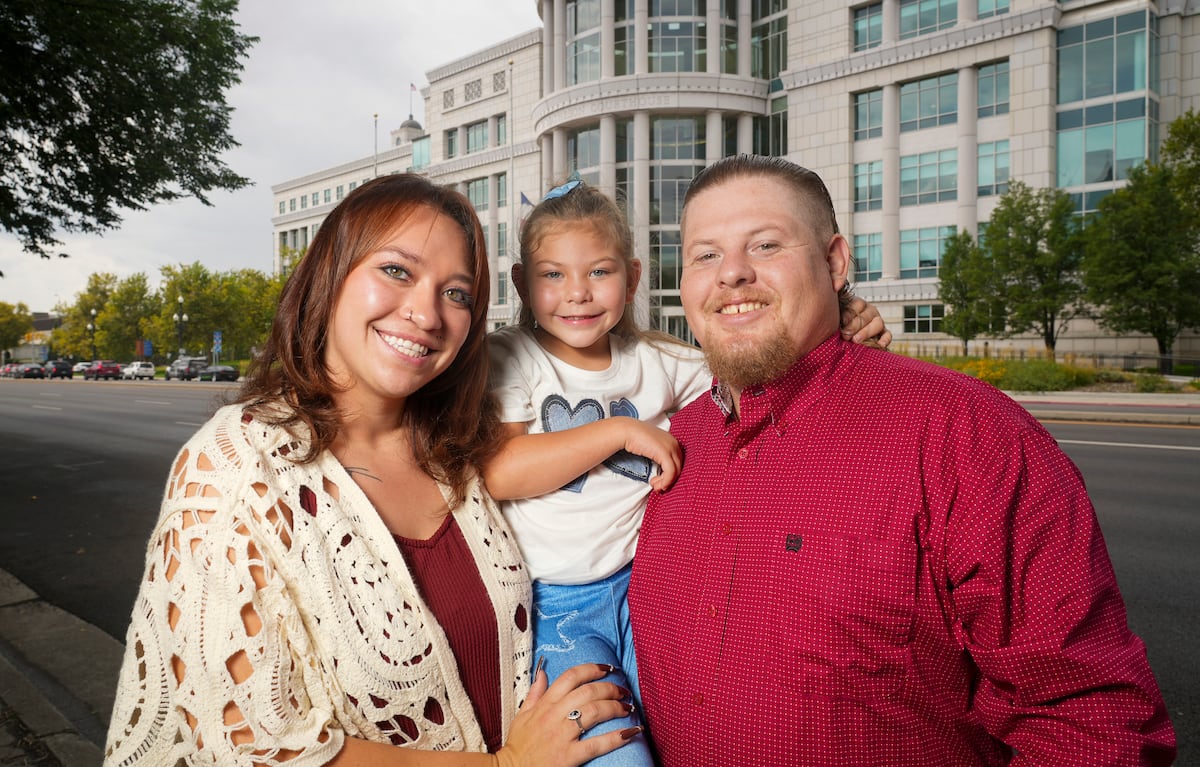The mother of a newborn injured at a Steward hospital in Utah “would have been better off delivering this baby at the bathroom of a gas station,” a judge said.

The first 39 weeks and two days of Anyssa Zancanella’s pregnancy were “so beautiful,” she remembers.
Zancanella sang to her unborn child every night, she said in an interview, and rejoiced in milestones like hearing her daughter’s heartbeat, seeing her in ultrasound images and decorating her nursery. As her due date approached in October 2019, the family’s attorneys later wrote, Zancanella’s first pregnancy had been ”normal and routine.”
Then her water broke while she was on a short vacation to Salt Lake County — hours away from her home and obstetrician in Wyoming. Relatives who had traveled with her searched online for the nearest hospital and hurried her to Jordan Valley Medical Center in West Valley City, then owned by Steward Health Care.
There, inexperienced nurses failed to react to signs that Zancanella’s baby was in distress, giving the mother “excessive” doses of the labor-inducing hormone Pitocin, over hours, while the on-call doctor was asleep in a room approximately 30 seconds away, the family contended in subsequent lawsuit.
Hospital staff didn’t intervene and perform a cesarean section delivery until Zancanella had been in the hospital for more than a day — care that deprived the baby of oxygen and damaged her brain so severely that doctors believe, according to court documents, that she will be disabled for life.
Third District Judge Patrick Corum, who found Steward liable in the medical malpractice case earlier this month, reached a blunt conclusion as he announced his decision on damages.
Zancanella “would have been better off delivering this baby at the bathroom of a gas station, or in a hut somewhere in Africa, than in this hospital,” he said. “Literally, this was the most dangerous place on the planet for her to have given birth.”
He awarded $951 million from Steward to Zancanella, her partner and their daughter, Azaylee.
The near-$1 billion award is one of the largest judgments in Utah history, according to Claggett & Sykes, the Las Vegas law firm that represented the family along with Barbara Gallagher of Kidwell & Gallagher, also in Nevada.
The award may have been even higher, the judge added, had Steward not stopped communicating with its attorneys and withdrawn from participating in court proceedings. Corum ultimately proceeded without the hospital chain’s input, hearing evidence and entering judgment against Steward by default.
“Had the defendant been here,” he said, “I think the testimony would have been lengthier and even more compelling, if that’s possible.”
Now the question is how and whether the family will be able to collect any damages from the beleaguered former hospital chain, which is in bankruptcy. It owes billions to creditors, with millions owed in Utah alone. Steward has 90 days from the judge’s Aug. 8 ruling on damages to appeal.
At 5, Azaylee loves to play and appears to be like any other child, but she doesn’t have the cognitive or executive function others do at her age, said Claggett & Sykes attorney David Creasy.
(Bethany Baker | The Salt Lake Tribune) Azaylee Zancanella-McMicheal sits for a portrait in a park in Salt Lake City on Wednesday, Aug. 27, 2025. In August, a judge ordered Steward Health Care to pay her and her family $951 million in damages for medical malpractice during Azaylee’s birth at a Steward hospital in Utah.
She struggles with seizures and takes medications daily to stave them off. Azaylee is generally nonverbal, saying only short words or phrases, and wears diapers. Zancanella said Wednesday that doctors believe Azaylee will never be able to work, drive a car or go to college, and will require constant care.
While making his ruling about damages, Corum quoted from Zancanella’s testimony. Azaylee, she said, “had her life stolen. We all did. We had her taken from us. She is trapped. I know that my daughter is in there, but she can’t come out and I think of that every day.”
Dallas-based attorney Eugene Sullivan, identified in court documents as deputy general counsel for Steward Health Care system, did not respond to multiple requests for comment. Steward had denied the lawsuit’s allegations in a May 2024 filing, saying that it did not hire the staffers who provided Zancanella’s care and that it was not liable for the family’s malpractice claims.
CommonSpirit Health acquired the hospital two years ago, transitioning it and four other formerly Steward-owned Utah medical centers from for-profit institutions to faith-based facilities. It’s now named Holy Cross Hospital–West Valley.
Laura Malaise, its chief nursing officer, declined to comment on the lawsuit. She said in a written statement that current staff are trained on best practices and are “regularly assessed to ensure they meet all national clinical standards.” CommonSpirit “is fully committed to providing excellent and safe care to all of our patients,” she said.
Cascading ‘failures’
(Rick Egan | The Salt Lake Tribune) Jordan Valley Medical Center, West Valley Campus, on Wednesday, Aug. 11, 2021. CommonSpirit Health acquired the hospital from Steward Health Care two years ago, and it’s now named Holy Cross Hospital–West Valley.
The care provided by Steward culminated in an outcome “so egregious, and so easily preventable,” Zancanella’s attorneys wrote in a pre-trial filing, that medical experts call similar instances “‘never events’ — a kind of event that should never occur in a safe, well-functioning hospital.”
Never events “signal a systemic breakdown in patient care,” they wrote, “not an unfortunate lapse in judgment or a close call.”
Zancanella was admitted around 10:30 p.m. on Oct. 12, 2019. About five hours later, the suit said, her nurses consulted with the on-call obstetrician and began pushing Pitocin through an IV.
Pitocin, the synthetic form of the naturally occurring hormone oxytocin, is used to start contractions and speed up labor, but it can also be used to control postpartum bleeding because these contractions can clamp blood flow to the uterus. If a mother has not yet given birth, this drug can restrict blood flow — and oxygen — to the baby.
That’s why health care staff are instructed to give limited amounts of the drug and to taper off, or stop the dose completely, if there’s no progress, according to a report Zancanella’s attorneys submitted from Michelle L. Murray, a registered nurse and nursing instructor from New Mexico.
Yet Zancanella’s nurses continued the hormone at an “excessive” dose for hours, Murray wrote, even as they should have seen the mounting troubling signs, like the baby’s blood pressure rising and no signs the injection was increasing dilation.
The lawsuit pointed out that both nurses assigned to care for Zancanella were novices — finishing their orientation on or around the day she was admitted to the hospital — and argued they were undertrained. An on-call charge nurse, who would ordinarily provide guidance to newer employees, was also not fully trained and never intervened, according to the suit.
“This was the very first, or one of the very first times, that either of the assigned bedside nurses had individually been assigned a laboring patient,” it said. One of the nurses later said the charge nurse “basically left her on her own” and “preferred not to help take care of the patient or communicate with the family,” according to the suit.
Fetal heart monitoring strips, Creasy said, recorded that the baby was in distress for hours. At one point, one of the nurses told the on-call doctor about the readings and that Zancanella had a fever, the suit said. But that doctor “abandoned” Zancanella and went back to sleep, it said.
Throughout, Zancanella said she was “terrified” and just “wanted her [daughter] to come out.” She said she trusted hospital staff were doing their jobs.
She ultimately gave birth via cesarean section just before 6 a.m. on Oct. 14, 2019. A nurse noted the baby had a “misshapened head,” with the front of her scalp “severely bruised and bulging” and her face “swollen.”
She was soon flown by helicopter to Primary Children’s Hospital in Salt Lake City for more intensive care. There, staffers noted she had “metabolic acidosis,” or too much acid in her blood, which can be a sign of asphyxia before or during birth. They also wrote that she possibly had been hurt by a lack of oxygen and blood flow before she was born — a complication called a hypoxic ischemic injury, which could harm her brain.
It wasn’t until days later, Zancanella said, that she and her partner Danniel McMicheal understood what this would mean for the rest of their daughter’s life.
The family filed the lawsuit, alleging multiple “failures” in care from Steward, in 2021.
(Bethany Baker | The Salt Lake Tribune) Danniel McMicheal, left, and Anyssa Zancanella stand together across from the Matheson Courthouse in Salt Lake City on Wednesday, Aug. 27, 2025. In August, a judge ordered Steward Health Care to pay the family $951 million in damages for medical malpractice during the birth of their daughter Azaylee, not pictured, at a Steward hospital in Utah.
‘An attempt to thwart justice’
Corum decided Zancanella, McMicheal and Azaylee should receive nearly $1 billion for the hospital’s flawed care and the lifelong impacts it will bring.
“The person she was to be, the person she deserved to be, is trapped inside a brain-damaged child,” Corum said. “I cannot think of anything more profound, total or complete than that loss.”
Steward’s participation in the case began to dwindle in 2024, Corum said. In May, three months before scheduled trial date, Steward’s attorneys asked for permission to withdraw from the case. They wrote that Steward had stopped communicating and was not paying their fees — and had given “no indication” that it “will pay for work done from now through trial.”
Corum approved their withdrawal and urged Steward to appoint new counsel, but that never happened. In his Aug. 3 ruling finding Steward liable, Corum wrote: “Indeed, since at least the early Spring of 2024, Defendants’ entire strategy seems to have been nothing other than an attempt to thwart justice and the judicial process.”
He added that the family was “admittedly reluctant” to ask for more money, because Steward didn’t show up for the subsequent three days of testimony before his verbal ruling on damages.
“The court is still, in a very, very odd way, reluctant to give what I think this case is actually worth,” he said, “because [the defendants are] not here, because I do not want to create issues that don’t need to be there.”
Regardless of Steward’s bankruptcy, the family should be able to collect at least half of the award, which represents punitive damages, said Jennifer Morales, another Claggett & Sykes attorney. Steward filed documents in its bankruptcy case on Wednesday establishing a trust to manage its assets and repay its debts.
‘How she should have been’
On Wednesday, Azaylee sat in her father’s lap during a visit to Salt Lake City, playing with credit cards she’d pulled from a purse. Zancanella said sometimes Azaylee will say a phrase, like “I told mom,” so clearly.
“And it’s like that’s her voice, that’s her, that’s how she should have been,” Zancanella said, “but she can’t be that person because she’s just locked up. She’s trapped.”
(Bethany Baker | The Salt Lake Tribune) Azaylee Zancanella-McMicheal plays on a tablet in a park in Salt Lake City on Wednesday, Aug. 27, 2025. In August, a judge ordered Steward Health Care to pay her family $951 million in damages for malpractice during her birth in a Steward hospital in Utah.
The nursery Zancanella worked so hard to decorate “did not get to stay that way,” she said, as she faced the need to provide her daughter with 24/7 care. With so many seizures, it’s impossible for Azaylee to sleep by herself.
Now, the whole family — including Zancanella’s youngest daughter, born 16 months after Azaylee — sleeps in one bedroom in a modified super bed, a king plus a twin. Zancanella’s grandmother sewed custom linens that stretch across them.
Azaylee’s family keeps extra oxygen available wherever they go, in case she has a seizure and needs it. They’ve retrofitted every door in their home with locks “way up high,” Zancanella said, where Azaylee can’t reach, because she has a tendency to bolt.
They watch their younger daughter grow, learning to crawl and talk and walk exactly when developmental milestones say she should, Zancanella said. That didn’t happen for Azaylee.
Their younger daughter, Zancanella said, is learning to swim under water, while Azaylee tries but can’t grasp that she needs to plug her nose and mouth. Her parents think Azaylee is aware of these differences and understands that others are communicating, often even knows what people are saying, but that she can’t talk back. They said it’s frustrating for her.
Azaylee receives physical and occupational therapy. Her family works with her at home and has garnered a support system of others whose children experienced similar trauma. Azaylee has started kindergarten for a few hours each day. Soon, Zancanella said, she’s going to get her own service dog to help detect seizures and be her “little partner in crime.”
As they spoke in an interview, Zancanella and McMicheal were occasionally interrupted by Azaylee, who was taking photos of herself on a tablet and exclaiming or giggling every so often as she scrolled through silly filters.
Zancanella and McMicheal said they try to focus on the reality in front of them and adjust to it accordingly. “Another thing,” Zancanella said, “is just patience.”
Note to readers •This story is available to Salt Lake Tribune subscribers only. Thank you for supporting local journalism.
Correction • 11:25 a.m., Aug. 28, 2025: This story has been updated to add a photo of Jordan Valley Medical Center in West Valley City when it was owned by Steward Health Care. An earlier version included a photo of Jordan Valley Medical Center in West Jordan, also owned at the time by Steward.
Source: Utah News







